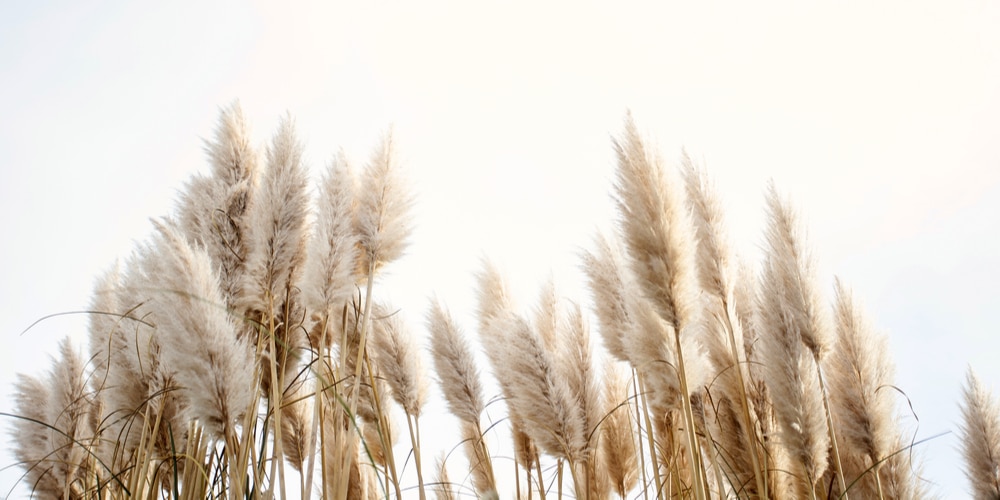Do you need something in your garden to make a statement? Black Pampas Grass might be the ideal option to make your landscape more attractive and unique. And the best part is that these plants are low-maintenance and relatively easy to grow.
Certain varieties are invasive in some parts of the United States. Indeed, under the ideal growing conditions these plants spread fast and form large masses.
But what can you do to grow black pampas grass in your garden? And what should you know about it? You’ll find all the information you need in this essential guide!
| Botanical Name | Cortaderia selloana |
| Common Name | Black Pampas Grass |
| Plant Type | Perennial |
| Flower Color | Female plants display fluffy plume-like clusters that can grow 1 to 3 feet long. They are usually silvery or creamy in color. This variety has darker-colored plumes. |
| Size When Mature | Between 5 and 10 feet tall. |
| Bloom Time | Late summer to early fall |
| Sun Requirements | Full Sun |
| USDA Hardiness Zones | Between 7 and 11 |
| Soil PH Range | Slightly acidic: ideally, it should be between 5.4 and 6.5 |
| Soil Type | Well-draining, better if fertile. |
| Water Needs | Low: when established, you won’t have to worry too much about watering these plants. |
| Native Area | South America |
What you Need to Know About Black Pampas Grass
Black Pampas Grass is ornamental grass native to Argentina and Brazil. In warm environments, this plant grows fast and tall. You should have no issues identifying Pampas grasses: these plants will grow to about 10 feet tall and display a unique-looking inflorescence of feathery blooms.
Depending on your hardiness zone, you might be able to enjoy your pampas grass’ blooms throughout the winter.
The plant isn’t hard to grow: after establishing itself in your yard, it won’t require much attention from your side. However, you might have to control it to prevent it from taking over your garden.
Don’t worry for your pets and kids: black pampas grass is non-toxic to humans and animals.
How to Care for Black Pampas Grass
As mentioned, taking care of black pampas grass is no rocket science. You won’t have much to worry about when growing this plant in the suitable USDA hardiness zone. However, you might benefit from learning about this plant’s requirements.
Light
Something these plants need is a lot of sunlight. Pick a spot where your pampas grass will receive at least six hours of direct lighting per day to get the most out of it.
If you can’t offer full sunlight, you can always plant it under partial shade. However, the plant might be less healthy with inadequate lighting.
Water and Soil Needs
Black pampas grass will adapt to most soil conditions, but it will grow best in rich, moist, and well-draining substrates. The ideal soil pH is slightly acidic: between 5.4 and 6.5.
Add some mulch around your plants to improve drainage and increase the soil’s nutrient content. Doing so will also help regulate the ground’s temperature and protect your plants from thermal shock.
This plant doesn’t require much water after its establishment: it will tolerate even extended periods of drought. However, it will benefit from occasional watering during the hot summer months.
Temperature Requirements
Pampas grasses are suitable for growing in warm regions. Black pampas do best in USDA hardiness zones between 7 and 11.
While it might survive in zone 6, this plant will not live through cold winters. Keep that in mind before planting it in your garden. Adding mulch can help to protect your plants from lower temperatures.
Fertilizer
These plants don’t require fertilizer. Under the ideal growing conditions, they will grow fast and might be hard to manage. If your substrate is poor, adding a layer of compost or manure will be enough to provide your plants with all the nutrients they need.
Common Diseases
Black pampas grass tolerates most pests and diseases. Consider pruning your plants to the ground every year to encourage new and healthy growth and prevent the appearance of diseases and other infections.
Compared to other plants, this one has a higher tolerance to wet soils and isn’t as susceptible to fungal infections.
Black Pampas Grass Propagation
Propagating pampas grass isn’t challenging, but it shouldn’t be something to do. Indeed this plant is invasive in several states and can become hard to manage as it spreads.
You can control this plant with herbicide treatments or cut its flowers to prevent seeding.
Related Article: Dwarf Pampas grass care


